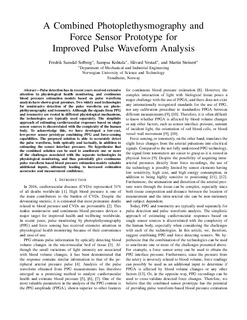A Combined Photoplethysmography and Force Sensor Prototype for Improved Pulse Waveform Analysis
Solberg, Fredrik Samdal; Kohtala, Sampsa Matias Ilmari; Vestad, Håvard Nitter; Steinert, Ralf Martin
Chapter
Accepted version

Åpne
Permanent lenke
http://hdl.handle.net/11250/2639678Utgivelsesdato
2019Metadata
Vis full innførselSamlinger
Originalversjon
10.1109/SENSORS43011.2019.8956487Sammendrag
Pulse detection has in recent years received extensive attention in physiological health monitoring, and continuous blood pressure estimation models based on pulse waveform analysis have shown great promises. Two widely used technologies for noninvasive detection of the pulse waveform are photo-plethysmography and tonometry. Although the signals from PPG and tonometry are rooted in different physiological mechanisms, the technologies are typically used separately. The simplistic approach of estimating cardiovascular responses based on single sensor sources is discorrelated with the complexity of the human body. To acknowledge this, we have developed a low-cost, low-power sensor prototype combining PPG and force-sensing capabilities. The proposed solution is able to accurately detect the pulse waveform, both optically and tactually, in addition to estimating the sensor interface pressure. We hypothesize that the combined solution can be used to ameliorate one or more of the challenges associated with the separate technologies in physiological monitoring, and thus potentially give continuous pulse waveform based blood pressure estimation models valuable additional inputs, ultimately leading to increased estimation accuracies and measurement confidence.